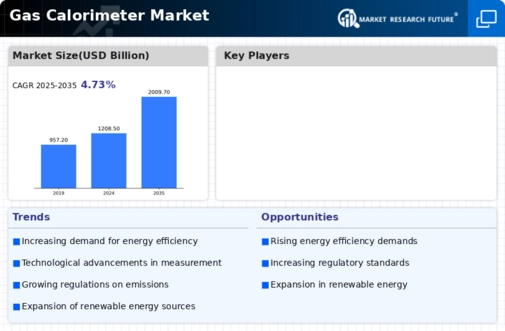Market Analysis
In-depth Analysis of Gas Calorimeter Market Industry Landscape
Gas calorimeter manufacturers are steering away from conventional designs, directing their focus towards tailoring gas calorimeters for precise end-use applications. Several instances of such advancements are highlighted below:
Yokogawa Electric Corporation pioneered the CM6G Gas Calorimeter, specifically engineered to measure and regulate the calorific value or Wobbe Index (WI) of sample gases. This variant employs differential pressure measurements between the sample gas and air flow rates via an orifice, converting these readings into digital signals for comparison through digital computations. The CM6G Gas Calorimeter finds utility in regulating thermal input for furnaces in steel and petrochemical industries and determining the calorific value of town gas.
Arelco ARC introduced the innovative Combustible Gas Analyzer CGA100, tailored to monitor the quality of all combustible gases. This analyzer assesses the combustion air requirement index (CARI), Wobbe Index, heating value, and specific gravity, primarily deployed in natural gas pipeline and town gas industries.
UNION Instruments GmbH unveiled the CWD2005 combustion calorimeters, devised specifically to ascertain gas quality, calorific value, Wobbe Index, specific gravity, and CARI. These precision instruments cater to the needs of steel plants, power plants, and coke ovens.
While these pioneering developments are in their nascent stages, they stand poised to broaden the applications of gas calorimeters across various industries. As gas calorimeter manufacturers persistently endeavor to augment their global market share, initiatives to enhance the adaptability and utility of these instruments are set to escalate during the forecast period. Consequently, the anticipated impact of the enhanced versatility of gas calorimeters on the global gas calorimeter market is projected to transition from a low level to a high magnitude over the forecast period.
The paradigm shift in gas calorimeter manufacturing prioritizes tailored solutions for specific industrial requirements. Yokogawa Electric Corporation's CM6G Gas Calorimeter, Arelco ARC's Combustible Gas Analyzer CGA100, and UNION Instruments GmbH's CWD2005 combustion calorimeters exemplify this shift, catering to distinct industry needs with precision and digital sophistication.
The developmental strides witnessed in these advanced gas calorimeters not only promise heightened accuracy in measuring gas properties but also underscore a trajectory towards diversifying their applications across sectors. As manufacturers invest in refining the adaptability of gas calorimeters, the forecasted impact on the global market is expected to surge, transitioning from a niche utility to a pivotal instrument across diverse industries. This evolution signifies a growing trend where gas calorimeters are customized to address the specific demands of varied industrial landscapes, promising an era of enhanced precision and utility in gas analysis.



Leave a Comment